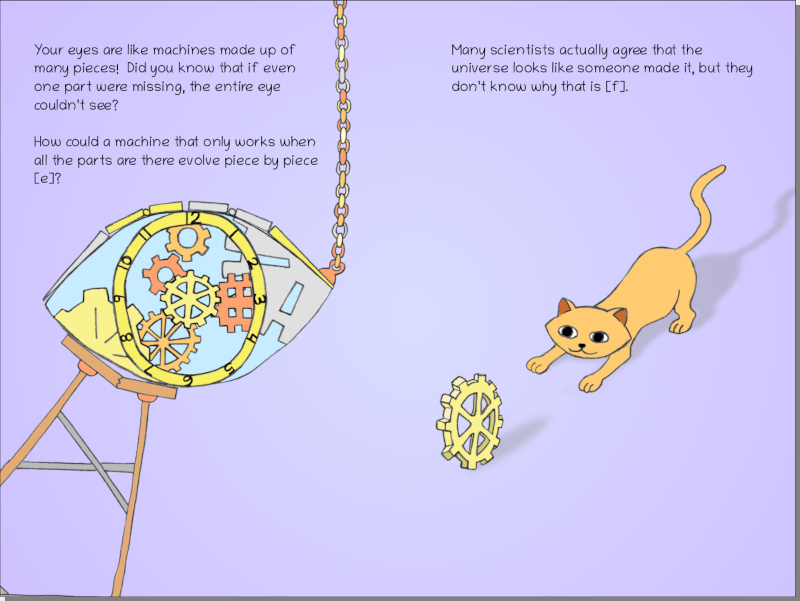Where Did the Universe Come From? is a book for young children, but it comes packed with a big fat parent notes section!
And, of course, you can preview the book and read the FAQ here or purchase it here.
(Why such a massive parent notes section on a kids’ book? We wanted to give parents and caregivers more context to the points that the book simplistically presents to the children…So, please enjoy the web-adapted version of the parent notes section found at the back of Where Did the Universe Come From?)
Topics Index
The universe began from nothing
The Bible is unique among holy books
The biblical creation text squares with modern scientific knowledge
Use your brain: The Bible says so!
The universe had a beginning
Does it make sense that the universe had a beginning? The main scientific theory up through the first half of the twentieth century was the Steady-State Theory, which said that the universe always existed. The Big Bang Theory, which is now the most accepted theory for explaining how the universe started, has stood the test of time and been strengthened by lots of evidence from new scientific discoveries.
The universe began from nothing
We also know that God made the universe from nothing:
“By faith, we understand that the ages were prepared by the word of God, so that what is seen has not been made out of things which are visible.” (Hebrews 11:3, New Heart English Bible)
“By wisdom the LORD founded the earth. By understanding, he established the heavens.” (Proverbs 3:19)
“In the beginning God created the heavens and the earth.” (Genesis 1:1)
Note that the phrase translated here as “the heavens and the earth” is a Hebrew phrase that refers to the entire universe, all of creation.
God created time and is outside of space and time:
“In hope of everlasting life, which God, who cannot lie, promised before time began;” (Titus 1:2)
God can only promise something before time began if He is outside of space and time.
Fine tuning and complexities
The universe is incredibly complex and shows many hallmarks of design throughout all of creation. Just a few examples:
DNA is so complex that it stores several encyclopedias worth of information, with the number of them being different depending on the creature.
Reading this article, it is obvious that it was made by an author intentionally and did not appear out of thin air. How much more is this true for something MORE complex than this book, such as the DNA within each of our cells?
Darwin’s theory of evolution can only explain MICRO-evolution (small changes like longer bird beaks, better camouflage, etc. as animals adapt to their environments.) Even Darwin admits it can’t explain irreducible complexities, that is, features that are made up of many different parts that are all useless unless ALL of them are there. Even a single cell in your body is an irreducible complexity, as it is made up of MANY complex parts. Darwin wasn’t aware of this in his time, and science still can’t explain it.
Plenty of famous atheists, or people who believe strongly that there is no God, admit that the universe looks designed.
Renowned skeptic Michael Shermer admits that the universe looks designed in his book (Shermer, 2006, p.65)
Biology professor and atheist Dr. Kenneth Miller admits that many things in the human body look designed, including but not limited to: protein molecules, ball and socket joints, cellular structures, and more (Brown University, 2008)
The Bible is unique among holy books
Religious holy books are not science books, in that they are not written to explain HOW things work so much as WHY they are. That said, they do make statements that can be tested as true or false against modern scientific knowledge, and any holy book that goes against known facts clearly can’t be true. So, if we want to know if a religion’s holy book has a chance of being true, we should first check and see if what that book says about known scientific facts is correct or not:
Buddhism and Hinduism say that the universe endlessly restarts again and again, but the most widely accepted scientific theory says that this isn’t true: It began once from nothing. The Hindu Vedas describe a universe that cycles and restarts many times (Klostermaier, 2007, p.496), and Buddhist ideas on the subject are similar.
In Islam, their holy book called the Quran claims that there are seven layers above Earth, with each one further and further out, and it suggests that the moon, planets, Sun, and stars are similar distances from Earth by describing them all as lamps in the very closest layer:
It speaks of seven layers of “heavens” above Earth (Quran 67:3, 71:15). It states that the “lamps” or “lanterns” are in the lower layer (Quran 41:12, 67:5), and lastly, when the “lamps” and the “lower layer” are described, we see planets, moon, and sun all referred to (Quran 37:6, 71:15-16).
Furthermore, it contradicts itself by claiming that the universe and everything in it were created in 6 days (Quran 25:59, 32:4, 50:38), whereas later, it contradicts itself by saying that the creation of everything took a total of 8 days (Quran 41:9-12).
The Quran also claims that Earth and everything on it were created before everything else (Quran 2:29, 41:9-12), and then it also claims the opposite, saying that Earth was created after the “heaven” (Quran 79:27-33).
For these reasons and others, these religions’ holy books can’t be true.
The biblical creation text squares with modern scientific knowledge
First, the universe was created, including stars and planets (Earth is a planet). The phrase often translated “the heavens and the earth” refers to the entire universe and everything in it. Science tells us that it was dark on Earth in the beginning because the atmosphere was so thick. This matches with what the Bible says:
“In the beginning God created the heavens and the earth. Now the earth was formless and empty, and darkness was on the surface of the watery depths. And God’s Spirit was hovering over the surface of the waters. And God said, “Let there be light,” and there was light.” (Genesis 1:1-3)
Then, the water cycle formed. Open space in the sky now separates clouds from ground-level water like rivers and oceans.
“And God made the expanse, and separated the waters which were under the expanse from the waters which were above the expanse. And God called the expanse Sky…” (Genesis 1:7-8)
God speaking poetically about early clouds during the creation period:
“When I made clouds its garment, and wrapped it in thick darkness” (Job 38:9)
Continents appeared, and shortly afterward, plants began to grow on the new dry land. Scientists know this from studying fossils and rocks.
“And God said, “Let the waters under the sky be gathered to one gathering, and let the dry land appear.” And it was so. And the waters under the sky gathered to their gatherings, and the dry land appeared…And God said, “Let the earth produce vegetation, plants yielding seed after its kind, and fruit trees bearing fruit with seed in it after its kind, on the earth.” And it was so.” (Genesis 1:9, 11)
This part happens during a period where the amount of oxygen in the air increased, and scientists affirm this increase in oxygen. This caused the atmosphere to no longer be permanently overcast, meaning anyone standing on Earth would be finally able to see the Sun, moon and stars well enough to use them to mark time and seasons.
“And God said, “Let there be lights in the expanse of the sky for the illumination of the day, to give light on the earth, and to rule the day and the night, and to separate between the day and the night. And let them be for signs, and for seasons, and for days, and for years;” (Genesis 1:14)
Notably, the Hebrew words behind the text here do NOT imply bringing the Sun and moon into existence at this time, just that they now can give light to Earth.
What scientists now call the Cambrian Explosion occurred, and as a result, the fossil record suddenly shows many new sea creatures that were never there before, all at once. Scientists are somewhat puzzled by this.
“And God created the large sea creatures, and every living creature that moves, with which the waters swarmed, after its kind, and every winged flying creature after its kind. And God saw that it was good.” (Genesis 1:21)
Land animals, and then humans, came next:
“And God made the wild animals of the earth after its kind, and the tame animals after its kind, and everything that crawls on the ground after its kind…And God created humankind in his own image. In God’s image he created him; male and female he created them.“ (Genesis 1:25, 27)
Use your brain: The Bible says so!
The Bible tells us that when we look at the universe, we should be able to understand that someone made it on purpose:
“The heavens declare the glory of God. The expanse shows his handiwork.” (Psalm 19:1)
“For since the creation of the world his invisible attributes, his eternal power and divine nature, have been clearly seen, being understood from what has been made. So they are without excuse.” (Romans 1:20)
The Bible tells us to use our brains and question everything so that we know what is true and false:
“But test all things; hold firmly that which is good.” (1 Thessalonions 5:21)
“A simple man believes everything, but the prudent man carefully considers his ways.” (Proverbs 14:15)
We should never believe something just because we heard it somewhere. Always have a reason for anything you believe!
“…always be ready to give an answer to everyone who asks you a reason concerning the hope that is in you, yet with humility and fear” (1 Peter 3:15)
“Now these were more noble than those in Thessalonica, in that they received the word with all readiness of the mind, examining the Scriptures daily to see whether these things were so.” (Acts 17:11)
Next steps
What impossible thing do you believe?
Read on to put it all together…

References:
Brown University. (2008, February 18). There Is ‘Design’ In Nature, Biologist Argues. ScienceDaily. Retrieved December 28, 2022 from www.sciencedaily.com/releases/2008/02/080217143838.htm
Quran. (Itani, Talal, Trans). (2012, May). Quran in English: Clear, Pure, Easy To Read. (n.p.). Retrieved January 23, 2023 from https://www.clearquran.com/downloads/quran-in-english-clearquran.pdf
Klostermaier, Klaus (2007). A Survery Of Hinduism: Third Edition. SUNY Press. Retrieved December 31, 2022 from https://books.google.com/books?id=E_6-JbUiHB4C&pg=PA496
The Holy Bible – New Heart English Bible. (Mitchell, Wayne A., Trans). (2022, Dec. 28). New Heart English Bible. Retrieved January 23, 2023 from https://nheb.net/files/NHEB%208.5×11.pdf
Shermer, Michael (2006). Why Darwin Matters: The Case Against Intelligent Design. Henry Holt and Company. Retrieved January 23, 2023 from https://books.google.com/books?id=cye1dMqRzEQC&pg=PA65#v=onepage&q&f=false
* * *
All Bible verses are quoted from the New Heart English Bible, a public domain translation. Full citation included above. All Quran verses were referenced from a modern English translation of the Quran by Mr. Talal Itani. Full citation included above.
